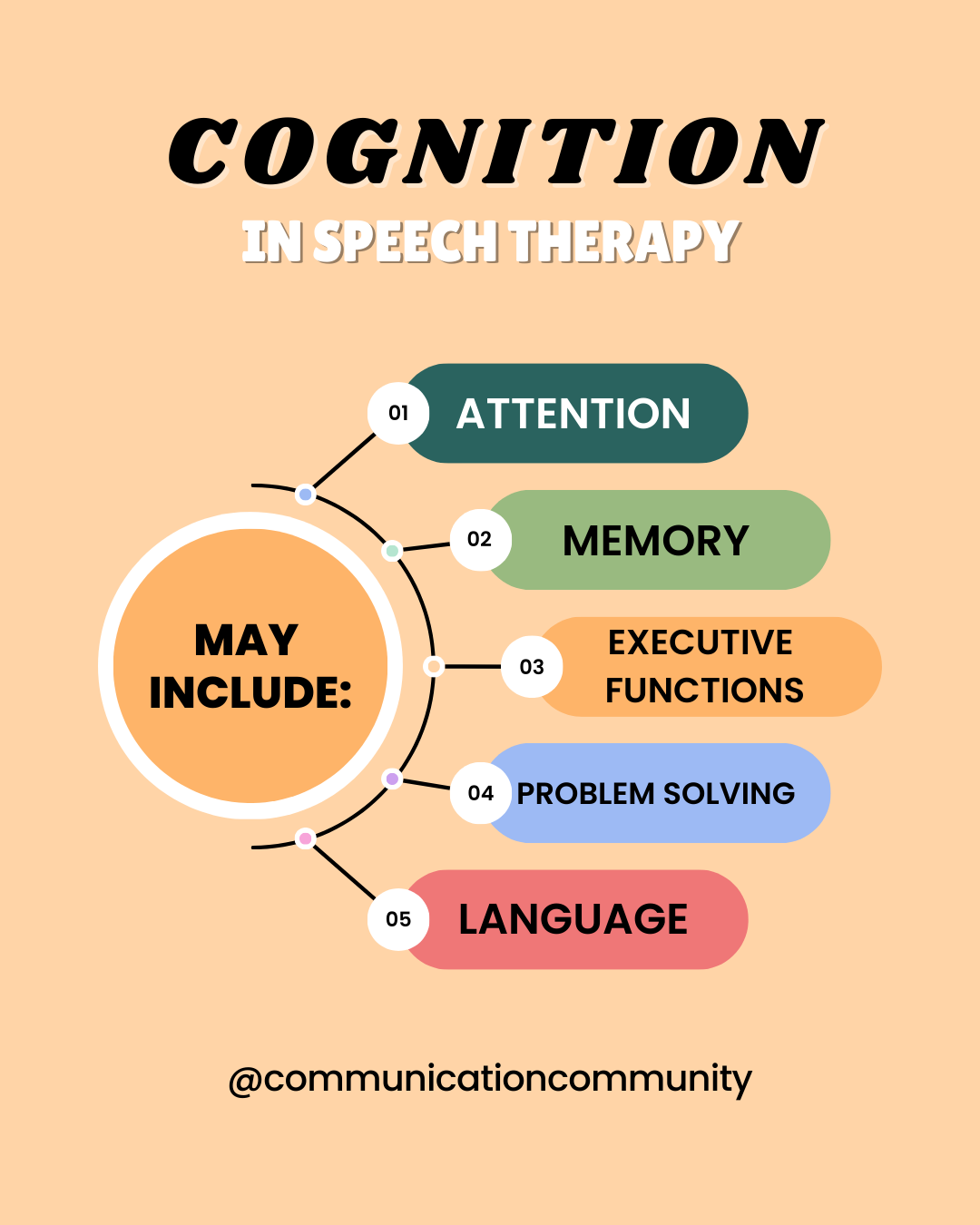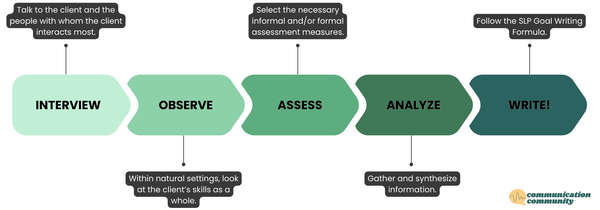
![How to Write Cognition Goals for Speech Therapy [with goal bank]](https://www.communicationcommunity.com/content/images/2024/07/Cognition-Speech-Therapy-Goals.png)
Cognition goals for speech therapy include the areas of attention, memory, problem-solving, executive functions, and using compensatory strategies. Individuals with cognitive-communicative deficits may benefit from speech therapy to address these areas and improve cognitive functioning.
Individuals with diagnosed cognitive-communicative disorders are usually referred for speech therapy services. These cognitive-communicative disorders may result from a brain injury or acquired neurological disease. Often, individuals with cognitive-communicative disorders receive speech therapy because they have communication difficulties, which impact their ability to participate in day-to-day activities that they once were able to. These may include social interactions, job duties, or academics.
Areas of cognitive-communicative challenges may include:


If you haven’t already, check out our article that outlines How to Write Speech Therapy Goals.
For the purpose of this article, we will discuss the process of goal writing for individuals receiving speech therapy for cognitive-communicative challenges.
The first step to writing goals is identifying the area(s) of need. These needs may be identified through formal and informal assessments, observations, and interviews. For example, a formal assessment to test cognitive-communicative function may include the RBANS, and an informal assessment may include a questionnaire about how the individual’s memory and attention skills may be impacting their life.
Getting a detailed case history and asking specific questions about what has been affecting the client and what they want to work on is key! For example, if they want to return to work, goals may be tailored to their job. If they want to live independently, goals may be related to completing activities of daily living (ADLs). For individuals receiving cognitive-communication services, person- and/or family-centered care has shown to be greatly beneficial for personal outcomes and clinical decision-making (like developing goals!).
Once you have identified the area(s) or need, you can begin creating the goals you are going to write and target.

As seen above, speech goals should be written with 3* components in mind: the DO statement, the CONDITION statement, and the CRITERION statement.
*Also commonly included is consistency (we often incorporate this!). By consistency, we mean: does the individual have to meet a specific criterion more than once? A common example of a consistency measure is meeting a goal across 3 consecutive sessions. This is usually something understood by the therapy organization/service provider and is sometimes/sometimes not included in the written goal itself. Including consistency statements ensure that the skill has been generalized and provides more reliable data that the skill has been properly mastered.
Example: [Client] will complete divided attention tasks, related to their profession, with 85% accuracy.
There you have it - an example using our Goal Writing Formula containing the DO + CONDITION + CRITERION statements for targeting cognitive-communicative skill areas.
The following are some examples of speech therapy goals that may be targeted in sessions. You can take these goals as is, or take the “do” statement from one, the “condition” from another, and the “criterion” from another. Remember: the best goals are the ones that most closely align with the client’s needs, and all clients are different!
Example #1: [Client] will complete divided attention tasks, related to their profession, with 85% accuracy.
Example #2: [Client] will complete alternating attention tasks, in structured settings, with 90% accuracy, across 2 consecutive sessions.
Example #3: [Client] will complete a sustained attention task, in a quiet environment, for 15 minutes, in 2/3 opportunities.
Example #1: [Client] will use external memory aids to retell daily activities, while communicating with a familiar partner, in 7/10 trials, across 2 out of 3 sessions.
Example #2: [Client] will use internal memory aids to recall the steps of a simple recipe (i.e., 3 to 4 steps), in a natural setting, with 75% accuracy.
Example #3: [Client] will recall at least 4/5 of their daily medications, using learned strategies, for 3 consecutive days.
Example #1: [Client] will determine 3 tasks to complete each day, related to their occupation, in 90% of opportunities.
Example #2: [Client] will self-monitor their ability to complete activities of daily living (ADLs), using a checklist while at home, with 80% accuracy.
Example #3: [Client] will create a grocery list for a week of meals, in a natural setting, with 80% accuracy, across 3 consecutive weeks.
Example #1: [Client] will identify a basic problem and its corresponding solution, related to personal ADLs, in 75% of opportunities.
Example #2: [Client] will identify whether or not they can solve a problem independently, while working on an academic assignment, in 8/10 trials.
Example #3: [Client] will state 2 possible problems, related to a medical issue, in 80% of opportunities.
Check out two of our top sellers:
Purchase these individually, or find the complete packets, PLUS hundreds of other resources, inside our Premium Community.
American Speech-Language-Hearing Association. (n.d.). Cognitive-communication disorders. Retrieved from https://www.asha.org/slp/clinical/cognitive-communication/
American Speech-Language-Hearing Association. (2004). Scope of practice in speech-language pathology. Retrieved from https://www.asha.org/policy/pp2004-00191/#sec1.3.23
The link has been copied!